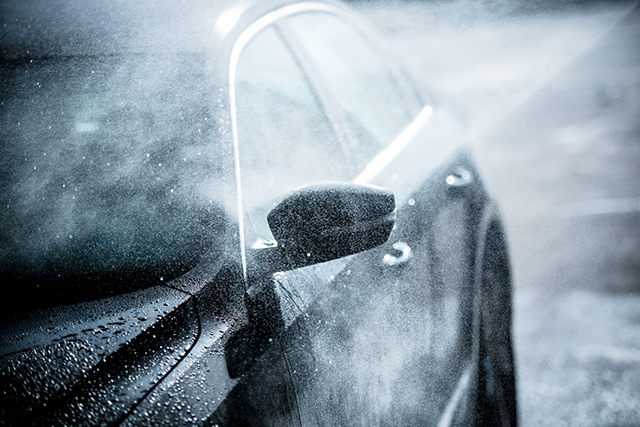During the winter months, or if you live in a particularly cold climate, washing your car can prove to be a difficult task as well being an unpleasant one. Water and shampoo solution can quickly freeze onto the surface of the vehicle, literally making it impossible to wash properly. Not only shampoo, but polish, wax and any other cleaning products can easily be affected by cold weather and not perform properly meaning that every part of the car cleaning process can be adversely affected. Detailcentral.com.au car care products supplies professional cleaning and detailing products for the automobile service industry.
During washing, water can also freeze around the car and cause a dangerous area of slippery ice that can be hazardous to yourself and passers by, and generally it can be very unpleasant trying to wash in freezing temperatures as your hands can quickly become numb and prevent you from performing cleaning and detailing tasks properly.

It is important however, to try and regularly wash your car especially in cold weather because there tends to an excess of dirt, grime and salt on the roads that if left sitting on the surface of your car can lead to damage and corrosion. Thankfully, there are a number of different things that can be done to help the car washing process in cold conditions.
To start with you should obviously ensure that you are correctly clothed and properly wrapped up to help conserve body heat and prevent your extremities from getting too cold and wet. Waterproof shoes or boots are a sensible idea to prevent feet from getting wet then subsequently very cold. Thick, lined trousers, a warm waterproof coat and a good hat are all essentials and even though you will need your hands free for the washing, some form of thin latex gloves worn during the washing process will noticeably help to take the edge off the cold and keep your fingers functioning.
Next, it is advisable to try and wash your car during the middle of the day when temperatures are most mild and when the sun is at its highest point in the sky. If the sun is out, even if you cannot noticeably feel any heat from it, it helps to try and position your car in the sunlight as this will help to prevent water from freezing on the surface, as, even if it is just reflected sunlight from a window etc you will be surprised at the effect it can have on the surface temperature of the vehicle.
If possible, you should take your car for a quick run prior to washing, or at least leave it running for a while with the window/mirror heaters and hot blowers turned on as this will, after a little while, help to raise the temperature of the exterior as well as heat from the engine and exhaust adding warmth into the body panels. It is logical to do this as you are preparing your equipment and filling the wash buckets so that by the time you come to put water on the car, surface temperatures will have increased a little. Your wash buckets should be filled with hot water which will further help to raise the surface temperature of the panels as they are being washed as well as keep your hands warm and supple.
It is the pre rinse and rinsing stages of the car washing process that can be the most difficult in cold conditions. Most people will use an outside cold water tap for this which greatly increases the likely hood of surface freezing occurring. The ideal solution to this really is either the use of a hot water pressure washer which can be adjusted to heat the temperature of the water being output accordingly, or by connecting your hosepipe to an interior or exterior converted hot water pipe/tap. These options though, can be expensive or time consuming to implement, so even though they are the best way to deal with cold weather washing, we will assume for the sake of argument that you will simply be using cold water from an outside tap for the rinsing parts of the process and so will focus on the other things that can be done to aid the process.
When washing, the wheels should be cleaned first (using a separate wash bucket) before moving onto the body as this will help to minimize the amount of time water is left sitting on the cold body panels. If the ground temperature is freezing then it would be a sensible ideal to lay down some rock salt prior to wetting the car to prevent your work area from quickly turning into an ice rink. When washing, it may be wise to work a little quicker that you would in more mild conditions to both try and keep your body temperature up and keep standing water sitting on the surface for a minimum amount of time, although, you should ensure that you still wash in a thorough and methodical manner.
If it is excessively cold and temperatures are sub zero then sometimes even all of these methods combined may still not be sufficient enough to prevent water from freezing on the car and the ground and so in these cases it is advisable to not attempt to wash and to wait for slightly milder conditions.
If you know that you are going to be attempting to wash your car in cold weather or during the winter months it is a good idea to properly prepare the exterior of your car before the cold weather sets in. If your car has been properly polished and thoroughly protected with a good quality, durable wax or sealant product then it will make it much easier to wash, meaning it will take less time and also that the surface is protected from road salts and winter grime, and so if you cannot wash for extended periods of time due to extreme cold you at least know your vehicle is protected and that the dirt and road salt cannot bond to and corrode the surface of your car.
If your vehicle is kept garaged you you will have the option of using a waterless wash product or detailing spray on the car while it is in the relative warmth of the garage to maintain it and keep it clean after an initial thorough wash, to prevent it from getting too dirty which means that you will have to rely less on washing outside with water.
If you have no choice other than to wash outside in cold weather then all the techniques mentioned here will help to prevent water from freezing on and around the car and to make the process a little easier and more bearable for you. However, they are not a complete guarantee against the onslaught of excessively cold weather and so if conditions are extremely cold and temperatures are sub zero it is sensible idea to simply hold off washing with water until temperatures pick up and conditions become a little more preferable.
Article Source: http://EzineArticles.com/6519320


